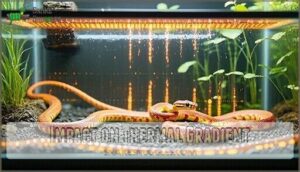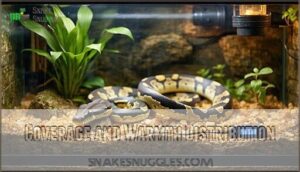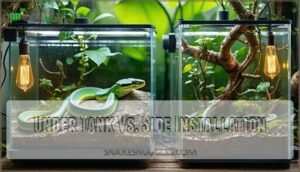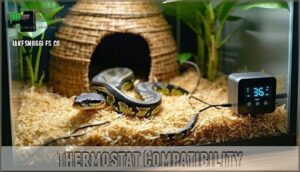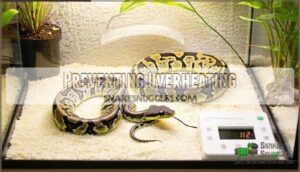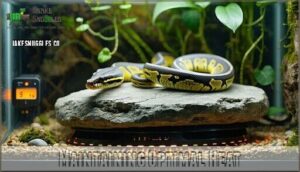This site is supported by our readers. We may earn a commission, at no cost to you, if you purchase through links.
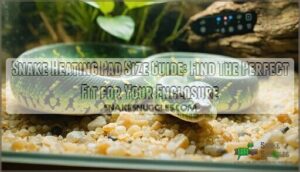
Your snake’s species matters too—ball pythons need larger heating areas than corn snakes. Always pair your pad with a thermostat to prevent overheating, as direct contact can reach dangerous temperatures.
Position the pad under one side of the tank to create a proper thermal gradient. The right setup makes all the difference between a stressed snake and a thriving one.
Table Of Contents
- Key Takeaways
- Choosing Snake Heating Pads
- Heating Pad Size Guide
- Snake Species Heating Needs
- Installing Heating Pads
- Maintaining Optimal Heat
- Frequently Asked Questions (FAQs)
- What size reptile heat mat do I need?
- What size heating pad for corn snake?
- What is a standard size heating pad?
- What watt heat mat for snake?
- How big is a snake heating pad?
- Do snakes need heating pads?
- What is the best heating pad for snake enclosures?
- What is a good heat mat for a pet snake?
- How do snake heating pads work?
- What are the best under tank snake heating pads?
- Conclusion
Key Takeaways
- You’ll need a heating pad that covers 30-40% of your snake’s tank floor to create a proper thermal gradient.
- Always pair heating pads with a thermostat to prevent overheating and maintain safe temperatures.
- Match the pad size and wattage to your snake species, tank size, and age for optimal comfort and health.
- Regularly monitor enclosure temperatures with a reliable thermometer to ensure consistent heat distribution.
Choosing Snake Heating Pads
Picking the right heating pad for your snake guarantees they stay warm and healthy in their enclosure.
You’ll need to evaluate size, power, and ease of use to match your snake’s specific needs.
Size Considerations
Choosing the right snake heating pad size is vital for your pet’s comfort.
Match the pad to your enclosure size and reptile size to guarantee proper heat distribution.
A good UTH size guide suggests covering about one-third of the tank base for a balanced heat gradient.
- Prevent cold spots by selecting the correct snake heat mat size.
- Too small? Heat won’t spread evenly.
- Too large? Overheating risks increase, which can be detrimental to your pet’s health and cause overheating.
Power and Wattage
Wattage impacts energy consumption, heat gradient, and pad lifespan.
Smaller reptiles need lower wattage, while larger snakes may require up to 50 watts for proper warmth.
Use this quick guide:
| Reptile Size | Wattage Requirements | UTH Size Guide |
|---|---|---|
| Small (Gecko) | 5-10W | 4"x6" heat pad |
| Medium (Python) | 20-30W | 8"x12" heat pad |
| Large (Boa) | 40-50W | 11"x17" heat pad |
Match wattage to your snake heating pad size for efficiency.
For ideal safety, always utilize a reptile-specific thermostat.
Temperature Regulation
Getting temperature regulation right in your snake enclosure is key to their health. Use a thermostat for precise temperature control and calibration.
Monitor ambient temperature and adjust for seasonal changes. Always consider species sensitivity to heat gradients.
- Invest in a reliable thermostat for consistent heat pad temperature.
- Check temperatures with a digital thermometer regularly. For accurate readings, consider using a quality temperature reader.
- Adjust settings to match your snake’s natural habitat. This step is crucial for maintaining the health of your snake.
Ease of Installation
A smooth heat pad installation starts with proper surface preparation—clean the tank bottom and remove oils for better adhesive strength.
During adhesive application, test placement first since heat pad adhesion is permanent.
Feet installation guarantees airflow and cord management, preventing overheating.
Heating Pad Size Guide
Choosing the right heating pad size guarantees your snake’s enclosure stays warm and comfortable without overheating.
By matching the pad to your tank’s dimensions, you’ll create an effective thermal gradient for your pet’s health.
Matching Pad Size to Enclosure
Matching the snake heating pad to the enclosure guarantees proper warmth.
Matching your snake’s heating pad to its enclosure ensures a comfortable, well-regulated habitat for their health and happiness.
Always consider:
- Enclosure Dimensions: The heat mat should cover about a third of the tank’s floor for a safe basking spot.
- Species Needs: Larger snakes need bigger pads; smaller ones, compact options.
- Reptile Size: Juveniles thrive with smaller terrarium heater sizes; adults need broader coverage to maintain comfort.
To prevent overheating, remember to affix the pad externally.
Impact on Thermal Gradient
A snake heating pad size directly affects the temperature gradient, shaping your snake’s health and behavior.
A well-established gradient creates temperature zones, ensuring your reptile can self-regulate within its ideal range. Without it, stress or illness can result.
Remember to review snake temperature requirements for optimal health. Use this guide:
Coverage and Warmth Distribution
Beyond creating thermal zones, proper heating pad size affects warmth distribution throughout your enclosure.
The right coverage guarantees your snake can access heat when needed while still having cooler areas to regulate their body temperature.
- Heat gradients form more naturally with correctly sized pads
- Your snake’s behavior shows when distribution is right
- Substrate depth directly impacts how warmth travels upward
- Too small pads create dangerous hotspots
- Perfect placement creates safe, comfortable environments
Snake Species Heating Needs
Each snake species requires specific heating temperatures based on their natural habitat, with tropical species needing warmer pads than desert or temperate species.
You’ll need to adjust your heating pad size and temperature settings according to your snake’s species, age, and enclosure size to create the proper thermal gradient.
This adjustment is crucial for the well-being of your snake, as different species have unique requirements.
Different Needs by Species
Your snake’s species determines its specific temperature requirements.
Corn snakes thrive in cooler environments (70-75°F) with 85°F basking spots, while leopard geckos need warmer ground temperatures (88-92°F).
Always consult a veterinarian about your specific reptile’s needs.
Different species have evolved unique thermoregulation strategies based on their natural habitats.
Remember that proper heat pad selection directly impacts your snake’s health, digestion, and overall activity levels.
Adjustments for Juveniles and Adults
How do you adjust heating for growing snakes? As your snake matures from juvenile to adult, its heating needs will change substantially.
- Juvenile snakes in smaller 10-20 gallon tanks need smaller heating pads with precise thermostat control
- Adult snakes require larger, more powerful heating pads for their 40+ gallon enclosures
Monitoring growth between 6-9 months helps determine when to upgrade heating equipment. Temperature gradients should be maintained but adjusted as your snake grows.
Under tank heaters should cover the area of the warm hide, regardless of age. To guarantee proper bone health, remember that snakes also require essential UV rays for proper development.
Basking Spot Requirements
Proper basking spots create essential temperature gradients for your snake’s health. Different species require specific heat ranges to properly digest food and maintain activity levels.
A proper thermal gradient is key for their well-being.
| Species | Best Temperature | Daily Basking Duration |
|---|---|---|
| Ball Python | 88-92°F | 8-10 hours |
| Corn Snake | 85-88°F | 10-12 hours |
| Boa Constrictor | 90-95°F | 8-10 hours |
Remember to adjust bulb distance based on enclosure size to maintain these optimal temperatures and ensure a proper thermal gradient.
Installing Heating Pads
You’ll need to place your heating pad correctly to guarantee your snake receives proper warmth distribution.
Clean the bottom glass surface thoroughly with alcohol before applying the adhesive pad to prevent air bubbles and guarantee the best heat transfer.
Under Tank Vs. Side Installation
In terms of heat pad placement, you’ll need to decide between under tank or side installation based on your snake’s habits.
Consider these factors:
- Heat distribution – under tank heaters provide belly heat that mimics natural ground warmth
- Species behavior – arboreal snakes may benefit from side-mounted pads
- Installation challenges – side mounting requires secure adhesion
- Safety concerns – under tank placement reduces direct contact risks
For reliable heating, consider purchasing a reptile under tank heater.
Thermostat Compatibility
Connecting your heating pad to a thermostat isn’t optional—it’s necessary for your snake’s safety. All heat sources should be linked to temperature control devices to prevent dangerous thermal spikes.
Place the thermostat probe inside the warm hide to regulate minimum temperature. Be aware that your reptile might move the probe, causing the system to misread temperatures.
Considering thermostat product compatibility is vital for safety. Many Herpstat and similar temperature monitoring devices offer reliable protection against inconsistent heating, ensuring your snake remains comfortable and safe.
Preventing Overheating
Beyond just connecting your thermostat, preventing overheating requires vigilance. Your snake’s health depends on maintaining safe temperatures without dangerous hot spots.
Follow these key steps to prevent overheating:
- Install a quality thermostat with automatic shutoff
- Use proper substrate depth (1-2 inches) over heat mats
- Create adequate ventilation around the UTH
- Monitor temperatures daily with an infrared gun
- Position heat mats on only 1/3 of the enclosure floor to ensure a safe environment for your snake, which is crucial for its health.
Maintaining Optimal Heat
You’ll need to regularly check your snake’s enclosure temperature with an accurate thermometer to prevent health issues caused by improper heating.
Maintaining the correct thermal gradient guarantees your snake can properly digest food and regulate its body temperature, which is essential for its overall well-being.
Monitoring Temperature With Thermometers
With constant vigilance, monitoring your snake’s enclosure temperature is non-negotiable for proper care.
You’ll need reliable temperature monitoring tools like digital thermometers or infrared temp guns for accurate readings. Place thermometers at both warm and cool ends to verify your thermal gradient.
Digital thermometers with temperature alarms offer peace of mind by alerting you to dangerous fluctuations. Accurate temperature readings are vital for snake health.
Regular temperature checks guarantee your heating pad maintains the ideal environment. This ensures that your snake receives the proper care, and accurate readings are essential for this purpose, providing peace of mind.
Ensuring Accurate Readings
Why do temperature readings sometimes fail?
Place your digital thermometer probes exactly where your snake rests for the most accurate measurements. Avoid interference from substrate that’s too deep.
Calibrate your thermometer regularly by comparing it to a known accurate device. Consistent monitoring throughout the day reveals temperature fluctuations that might affect your snake’s health.
Digital thermometers typically provide more reliable readings than analog versions for proper reptile heat mat management, which is crucial for proper management.
Troubleshooting Heating Pad Issues
When your reptile heating pad isn’t working properly, check these common issues.
First, inspect for uneven heating using an infrared thermometer to identify cold or hot spots.
Temperature spikes often indicate thermostat errors or faulty wiring.
Adhesive failure causes pads to detach, reducing effectiveness.
Regularly test your temperature control system to prevent overheating that threatens your snake’s health.
Most pad malfunctions can be detected early with consistent monitoring, which helps prevent overheating.
Frequently Asked Questions (FAQs)
What size reptile heat mat do I need?
Choose a heat mat that covers 1/3 to 1/2 of your tank’s floor area. For juvenile reptiles, use smaller mats. Larger tanks (50+ gallons) need bigger mats to maintain proper temperatures.
What size heating pad for corn snake?
While many assume bigger is better, you’ll want a heat mat covering 1/3 to 1/2 of your corn snake’s tank floor. For most enclosures, an 8"x12" or 11"x11" heating pad works perfectly.
What is a standard size heating pad?
Standard heating pads for reptiles typically measure 6"x8" for small enclosures, 8"x12" for medium tanks, and 11"x17" for larger setups. You’ll want to cover about 1/3 of your tank’s floor area.
What watt heat mat for snake?
For your snake’s heating mat, you’ll need 5-50 watts depending on tank size.
Smaller enclosures work well with 5-15W mats, while larger tanks (50+ gallons) require 30-50W for proper temperature maintenance.
How big is a snake heating pad?
Heating pads for snakes typically range from small (5"x6") to large (17"x24") sizes. You’ll need to cover about 1/3 of your enclosure, matching the size to your tank and snake species.
Do snakes need heating pads?
Yes, you’ll need heating pads for your snake as they’re ectothermic creatures requiring external heat sources.
They rely on proper warmth for digestion, immune function, and overall health in their enclosure.
What is the best heating pad for snake enclosures?
Your cold-blooded roommate will thank you.
For ideal snake comfort, you’ll want an Ultratherm heat pad (11"x11") paired with a Herpstat thermostat.
It provides consistent belly heat without exceeding 100°F, preventing burns.
What is a good heat mat for a pet snake?
You’ll need a quality heat mat that covers 30-50% of your enclosure floor.
Choose wattage based on tank size, maintain temperatures around 90°F, and always pair it with a reliable thermostat for safety.
How do snake heating pads work?
You might think they’re complicated, but snake heating pads are simple.
They create a warm surface by transferring heat to the tank floor, keeping your snake cozy.
Pair one with a thermostat for perfect control.
What are the best under tank snake heating pads?
The Zoo Med Reptitherm UTH and Ultratherm heat pads are top choices.
They’re reliable, energy-efficient, and provide steady warmth.
Pair them with a thermostat to guarantee your snake’s enclosure stays safe and cozy.
Conclusion
Mastering the art of choosing the right heating pad is almost as essential as mastering snake husbandry itself.
A proper snake heating pad size guide guarantees your scaly friend thrives with the perfect thermal gradient.
Match the pad size to your enclosure, use a reliable thermostat, and regularly monitor temperatures.
It’s not just about warmth—it’s about comfort and health.
With a setup this precise, you’ll create a cozy environment that keeps your snake happy, healthy, and stress-free.
- http://lllreptile.com/store/catalog/reptile-supplies/heat-pads-heat-panels-heat-cable-and-rocks/-/zoo-med-10-to-20-gallon-heat-pad/
- https://reptilekages.com/pages/snake-enclosure-guide?srsltid=AfmBOoq0HW3ljWt7lWBy2R9Kf_jkKSyt7a22qKta1x85Evg5YFM1al1z
- https://talis-us.com/blogs/news/snake-heating-pads-a-guide-to-safe-and-effective-heat-sources?srsltid=AfmBOoqppBy7oRNMF2690HxHR8N2DIV_xZ39rrKoX6SfBfxEHVKgbQir
- https://www.quora.com/Can-I-use-a-10-inch-by-20-inch-heating-pad-for-my-55-gallon-glass-tank-for-my-snake-or-should-I-try-to-find-a-different-size
- https://www.xyzreptiles.com/correctly-using-reptile-heating-pad/



